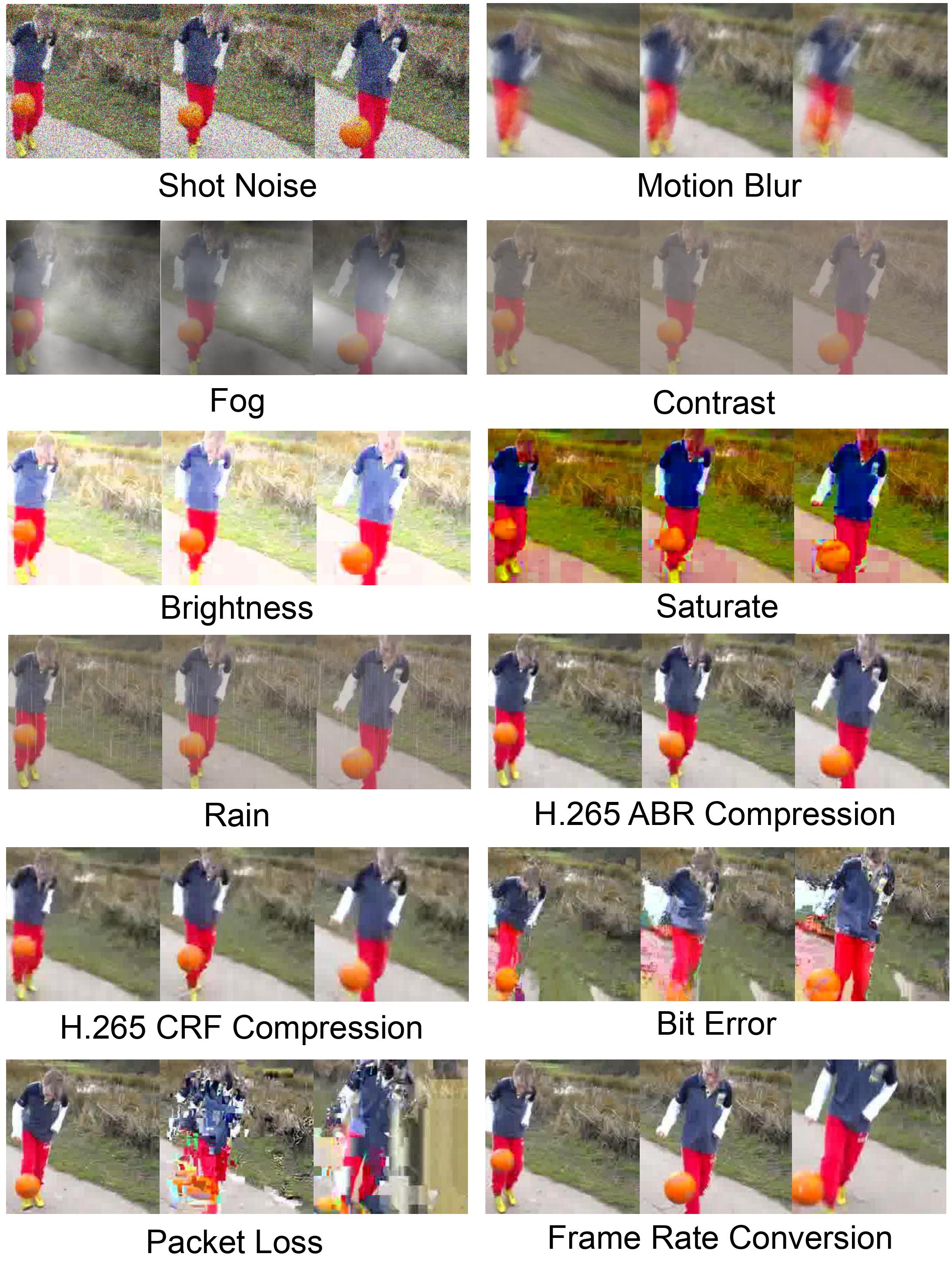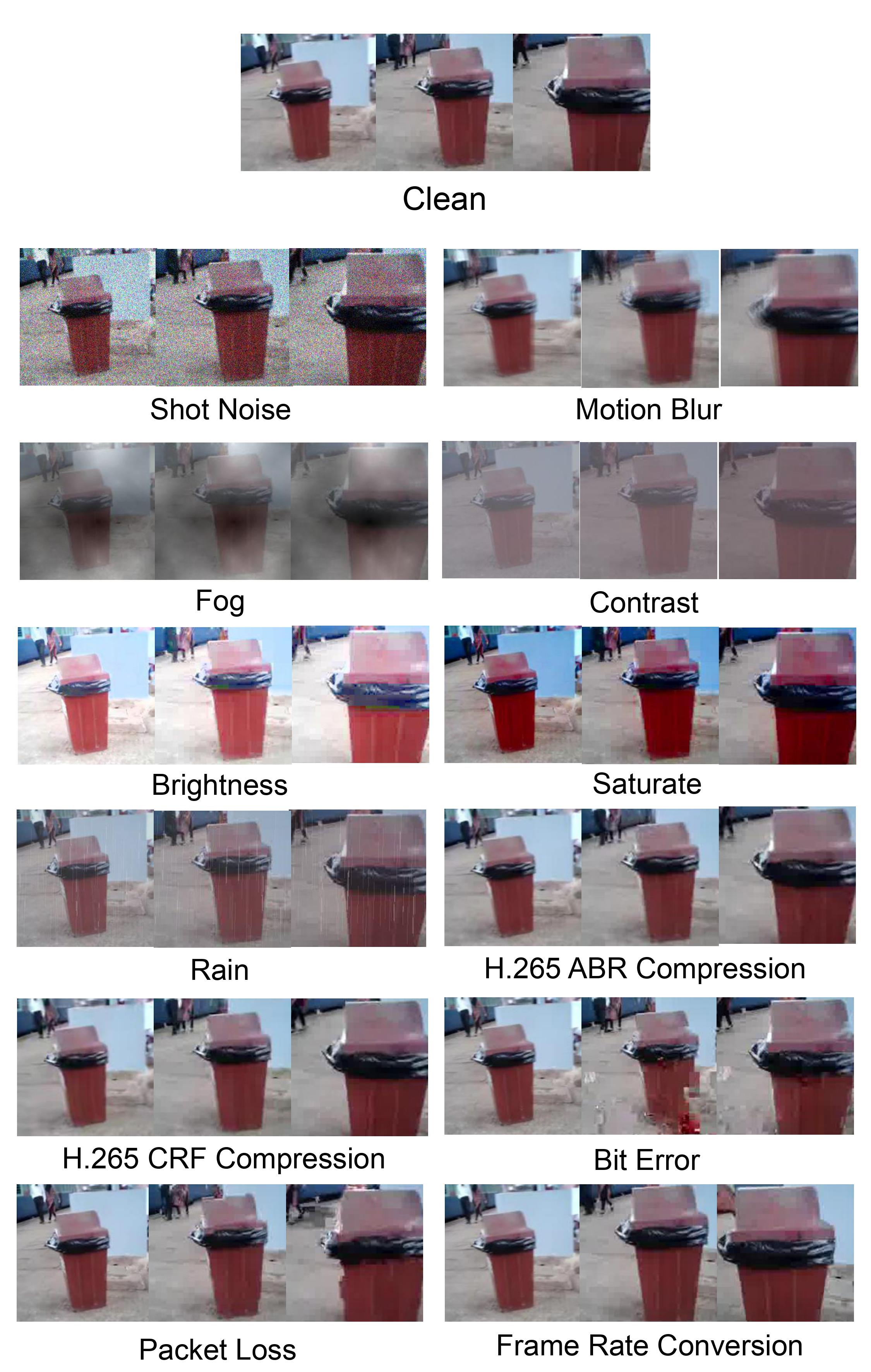This repositery contains the code for NeurIPs Benchmark and Dataset Track 2021 paper - Benchmarking the Robustness of Spatial-Temporal Models Against Corruptions.
Python 2.7 and 3.7, Pytorch 1.7+, FFmpeg are required.
pip3 install - requirements.txt
Download original Kinetics400 from link.
The Mini Kinetics-C contains half of the classes in Kinetics400. All the classes can be found in mini-kinetics-200-classes.txt.
Corruption robustness of spatial-temporal models trained on clean Mini Kinetics and evaluated on Mini Kinetics-C.
| Approach | Reference | Backbone | Input Length | Sampling Method | Clean Accuracy | mPC | rPC |
|---|---|---|---|---|---|---|---|
| TimeSformer | Gedas et al. | Transformer | 32 | Uniform | 82.2 | 71.4 | 86.9 |
| 3D ResNet | K. Hara et al. | ResNet-50 | 32 | Uniform | 73.0 | 59.2 | 81.1 |
| I3D | J. Carreira et al. | InceptionV1 | 32 | Uniform | 70.5 | 57.7 | 81.8 |
| SlowFast 8x4 | C. Feichtenhofer at al. | ResNet-50 | 32 | Uniform | 69.2 | 54.3 | 78.5 |
| 3D ResNet | K. Hara et al. | ResNet-18 | 32 | Uniform | 66.2 | 53.3 | 80.5 |
| TAM | Q.Fan et al. | ResNet-50 | 32 | Uniform | 66.9 | 50.8 | 75.9 |
| X3D-M | C. Feichtenhofer | ResNet-50 | 32 | Uniform | 62.6 | 48.6 | 77.6 |
For fair comparison, it is recommended to submit the result of approach which follows the following settings: Backbone of ResNet-50, Input Length of 32, Uniform Sampling at Clip Level. Any result on our benchmark can be submitted via pull request.
Download original Something-Something-V2 datset from link.
The Mini SSV2-C contains half of the classes in Something-Something-V2. All the classes can be found in mini-ssv2-87-classes.txt.
Corruption robustness of spatial-temporal models trained on clean Mini SSV2 and evaluated on Mini SSV2-C.
| Approach | Reference | Backbone | Input Length | Sampling Method | Clean Accuracy | mPC | rPC |
|---|---|---|---|---|---|---|---|
| TimeSformer | Gedas et al. | Transformer | 16 | Uniform | 60.5 | 49.7 | 82.1 |
| I3D | J. Carreira et al. | InceptionV1 | 32 | Uniform | 58.5 | 47.8 | 81.7 |
| 3D ResNet | K. Hara et al. | ResNet-50 | 32 | Uniform | 57.4 | 46.6 | 81.2 |
| TAM | Q.Fan et al. | ResNet-50 | 32 | Uniform | 61.8 | 45.7 | 73.9 |
| 3D ResNet | K. Hara et al. | ResNet-18 | 32 | Uniform | 53.0 | 42.6 | 80.3 |
| X3D-M | C. Feichtenhofer | ResNet-50 | 32 | Uniform | 49.9 | 40.7 | 81.6 |
| SlowFast 8x4 | C. Feichtenhofer at al. | ResNet-50 | 32 | Uniform | 48.7 | 38.4 | 78.8 |
For fair comparison, it is recommended to submit the result of approach which follows the following settings: Backbone of ResNet-50, Input Length of 32, Uniform Sampling at Clip Level. Any result on our benchmark can be submitted via pull request.
To help researchers reproduce the benchmark results provided in our leaderboard, we include a simple framework for training and evaluating the spatial-temporal models in the folder: benchmark_framework.
Assume the structure of data directories is the following:
~/
datadir/
mini_kinetics/
train/
.../ (directories of class names)
...(hdf5 file containing video frames)
mini_kinetics-c/
.../ (directories of corruption names)
.../ (directories of severity level)
.../ (directories of class names)
...(hdf5 file containing video frames)
Train I3D on the Mini Kinetics dataset with 4 GPUs and 16 CPU threads (for data loading). The input lenght is 32, the batch size is 32 and learning rate is 0.01.
python3 train.py --threed_data --dataset mini_kinetics400 --frames_per_group 1 --groups 32 --logdir snapshots/ \
--lr 0.01 --backbone_net i3d -b 32 -j 16 --cuda 0,1,2,3
Test I3D on the Mini Kinetics-C dataset (pretrained model is loaded)
python3 test_corruption.py --threed_data --dataset mini_kinetics400 --frames_per_group 1 --groups 32 --logdir snapshots/ \
--pretrained snapshots/mini_kinetics400-rgb-i3d_v2-ts-max-f32-cosine-bs32-e50-v1/model_best.pth.tar --backbone_net i3d -b 32 -j 16 -e --cuda 0,1,2,3

